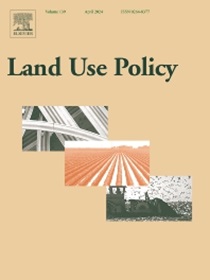将 BIM/IFC 作为三维土地管理系统中公寓权利登记的输入--网络服务原型
IF 6
1区 社会学
Q1 ENVIRONMENTAL STUDIES
引用次数: 0
摘要
对三维土地管理系统(LAS)的需求与日俱增。为此,在三维土地管理系统领域开展了有关数据源、三维权利、限制和责任登记以及传播服务的研究。在这一背景下,BIM/IFC 模型被认为是三维土地测量系统的有前途的数据源,尽管尚未对这些模型在实践中的再利用进行充分研究。对来自实践的 BIM/IFC 模型进行评估至关重要,因为这些模型是为不同目的而创建的,符合各种设计标准。本文研究了在 3D LAS 中使用真实世界的 BIM/IFC 模型进行公寓产权登记时遇到的技术挑战。它根据四个技术标准对五个荷兰真实世界的 BIM/IFC 模型进行了验证,这四个标准是:IfcSpace 的存在、几何有效性、无重叠和地理参照。验证结果表明,所收集的 BIM/IFC 模型缺乏地理参考、IfcSpace 和与荷兰 3D LAS 中各自法定单位相关的属性参考。经过验证后,这些模型被存储到 3D LAS 数据库管理系统(DBMS)中,在该系统中,根据土地管理域模型(LADM - ISO 19152:2012),用权利、限制和责任(RRR)信息丰富了法律空间。3D LAS DBMS 的内容在网络浏览器中可视化。此外,还介绍了网络服务的设计,旨在实现验证、转换和可视化过程的自动化。论文最后根据验证结果为 BIM/IFC 模型的创建者提供了建议和指导,并为实施验证网络服务提出了挑战和建议。本文章由计算机程序翻译,如有差异,请以英文原文为准。
BIM/IFC as input for registering apartment rights in a 3D Land Administration Systems – A prototype webservice
The need for 3D Land Administration Systems (LAS) is growing. In this respect, research is carried out in the field of 3D LAS with respect to data sources, registration of 3D Rights, Restrictions and Responsibilities and dissemination services. Within this context, BIM/IFC models are considered promising sources for 3D LAS, even though the reuse of such models from practice has not yet been examined adequately. Evaluating BIM/IFC-models from practice is crucial, since they are created for different purposes, fulfilling various design criteria. This paper investigates the technical challenges encountered when using real-world BIM/IFC-models for apartment rights’ registration in a 3D LAS. It addresses the validation of five Dutch real-world BIM/IFC-models against four technical criteria, namely: existence of IfcSpace; geometric validity; no overlap and georeferencing. The results of the validation show that the collected BIM/IFC-models lack georeference, IfcSpace and a reference to attributes related to the respective legal units in the Dutch 3D LAS. After validation the models are stored in a 3D LAS Database management system (DBMS), in which the legal spaces are enriched with information of the Rights, Restrictions and Responsibilities (RRR’s) in line with the Land Administration Domain Model (LADM - ISO 19152:2012). The contents of the 3D LAS DBMS are visualised in a web viewer. Additionally, the design for a webservice is introduced, aiming to automate the process of validation, conversion and visualisation. The paper concludes with recommendations and guidelines for creators of BIM/IFC-models based on the outcome of the validation, as well as challenges and recommendations for implementing a validation webservice.
求助全文
通过发布文献求助,成功后即可免费获取论文全文。
去求助
来源期刊

Land Use Policy
ENVIRONMENTAL STUDIES-
CiteScore
13.70
自引率
8.50%
发文量
553
期刊介绍:
Land Use Policy is an international and interdisciplinary journal concerned with the social, economic, political, legal, physical and planning aspects of urban and rural land use.
Land Use Policy examines issues in geography, agriculture, forestry, irrigation, environmental conservation, housing, urban development and transport in both developed and developing countries through major refereed articles and shorter viewpoint pieces.
 求助内容:
求助内容: 应助结果提醒方式:
应助结果提醒方式:


